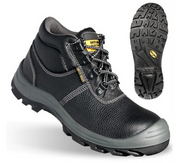Protective Footwear - Selecting The Right Safety Shoes
31st Jan 2019
There are multiple factors to consider when selecting the most appropriate foot protection. The goal is to make sure that your feet are comfortable, supported, and protected. A pair of safety shoes is an effective piece of personal protective equipment. However, the hazards are not only falling objects or fork trucks rolling over toes, but discomfort due to improper fit and selection. Choosing the appropriate safety shoe could prevent foot related problems like bunions, corns, calluses, hammertoes, and even prevent discomfort to the legs, hips, and back.

Consider these tips when selecting your next pair.
Safety should be the initial consideration when selecting the correct pair of protective footwear. There are many options in the market but you should choose a pair that will protect your feet from the hazards present. A combination of safety toe caps, metatarsal guards (protection for the top of the foot), steel plate soles (puncture resistant), sole material (slip resistance, electrical insulation, flexibility, and hardness), and overall construction materials used should be considered.
Fit is very important! Did you know that the human foot actually grows during the day and shrinks while you sleep? While that’s not entirely true, everyone’s feet are slightly larger after a hard day’s work. This means the end of the day is the best time to try on a new pair of shoes or boots. Making sure your new shoes fit well is key to preventing future discomfort. About one-third of adult men are wearing shoes that don’t fit properly, so take the time to ensure you are selecting the proper size.
Comfort is a must! The majority of quality safety shoes and boots will not stretch or need a break in period. Make sure that when you’re test driving potential footwear, your feet are immediately comfortable. Areas of comfort include appropriate space in the toe box, no pinching or cramping at the ball of the foot or toe area, and adequate support in the arch and heel. Make sure the padding and materials used are adequate for your work climate. Utilizing a shoe with moisture control technology for both warm and cold climates is a great option, but can affect how your shoe fits. When feet are comfortable, your knees, hips, and lower back are better aligned and supported. Be aware that no footwear can provide protection against all injuries. Hazards must be controlled by elimination, engineering controls, and administrative controls primarily. Relying on PPE alone is not acceptable. However, by selecting the correct shoe for your work environment and personal needs, you will have the best personal protection for preventing foot related injuries should other controls fail.

